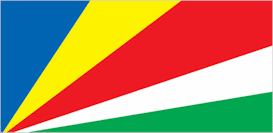Seychelles - People
 The U.S. government estimates the total population at 92,000 (July 2015 estimate). About 90% of the Seychellois live on Mahe Island. Most others live on Praslin and La Digue, with the remaining smaller islands either sparsely populated or uninhabited. The Seychelles, about 1,500 kilometers off the African coast and about 3,000 km southwest of India, is the smallest African state in terms of population. Most Seychellois are descendants of early French settlers and the African slaves brought to the Seychelles in the 19th century by the British, who freed them from slave ships on the East African coast. Indians and Chinese (1.1% of the population) account for the other permanent inhabitants. In 2006, about 4,000 expatriates lived and worked in Seychelles. Of those, about 65 were American.
The U.S. government estimates the total population at 92,000 (July 2015 estimate). About 90% of the Seychellois live on Mahe Island. Most others live on Praslin and La Digue, with the remaining smaller islands either sparsely populated or uninhabited. The Seychelles, about 1,500 kilometers off the African coast and about 3,000 km southwest of India, is the smallest African state in terms of population. Most Seychellois are descendants of early French settlers and the African slaves brought to the Seychelles in the 19th century by the British, who freed them from slave ships on the East African coast. Indians and Chinese (1.1% of the population) account for the other permanent inhabitants. In 2006, about 4,000 expatriates lived and worked in Seychelles. Of those, about 65 were American.
Seychelles culture is a mixture of French and African (Creole) influences. Creole is the native language of 94% of the people; however, English and French are commonly used. English remains the language of government and commerce. About 92% of the population over age 15 is literate, and the literacy rate of school-aged children has risen to well over 98%. Increases are expected, as nearly all children of primary school age attend school, and the government encourages adult education.
In 1976, the Seychelles government made Creole its third official language, alongside French and English. Although Creole is the native language for most Seychellois, this language policy change has remained contentious. While some have hailed it as essential to democracy, others condemned it for widening the nation's socioeconomic divide. After describing the Seychelles' modern demography and trilingual policies, details surrounding this controversy are presented. The policy issues raised help shed light on Creole-speakers, a group whose interests are often overlooked in language planning discussions for minority empowerment.
There is a historical educational gap between Creoles and Seychellois of white or Asian origin, which has been a factor in the continuing political and economic domination of Seychelles by whites and Asians. Despite a significant Creole majority, the President, the Health Minister, the Foreign Minister, most principal secretaries, and almost the entire merchant and financial class are white or Asian. The Government was attempting to close this gap through universal access to public education, but the formalization and teaching of Creole made it more difficult for Creole students to learn English and French at a competitive level. Further, the political domination by whites seemed unyielding since by the 1990s the elected leadership of the majority party, and that of most of the several opposition parties, was white. Seychelles has no indigenous population and was first permanently settled by a small group of French planters, African slaves, and South Indians in 1770. Seychelles’ modern population is composed of the descendants of French and later British settlers, Africans, and Indian, Chinese, and Middle Eastern traders and is concentrated on three of its 155 islands – the vast majority on Mahe and lesser numbers on Praslin and La Digue.
Seychelles’ population grew rapidly during the second half of the 20th century, largely due to natural increase, but the pace has slowed because of fertility decline. The total fertility rate dropped sharply from 4.0 children per woman in 1980 to 1.9 in 2015, mainly as a result of a family planning program, free education and health care, and increased female labor force participation. Life expectancy has increased steadily, but women on average live 9 years longer than men, a difference that is higher than that typical of developed countries.
The combination of reduced fertility and increased longevity has resulted in an aging population, which will put pressure on the government’s provision of pensions and health care. Seychelles’ sustained investment in social welfare services, such as free primary health care and education up to the post-secondary level, have enabled the country to achieve a high human development index score – among the highest in Africa. Despite some of its health and education indicators being nearly on par with Western countries, Seychelles has a high level of income inequality.
An increasing number of migrant workers – mainly young men – have been coming to Seychelles in recent years to work in the construction and tourism industries. As of 2011, foreign workers made up nearly a quarter of the workforce. Indians are the largest non-Seychellois population – representing half of the country’s foreigners – followed by Malagasy.
The society is largely matriarchal, with 75 percent of births out-of-wedlock in 1998. There were no reports of societal discrimination against unwed mothers, and fathers are required by law to support their children. The age of consent was lowered from 16 to 14 in 1993, and 13 percent of all births in 1998 occurred to women under 20 years of age. Girls are not allowed to attend school when they are pregnant, and many do not return to school after the birth of a child.

|
NEWSLETTER
|
| Join the GlobalSecurity.org mailing list |
|
|
|

